![]() National Survey of Victim-Offender Mediation Programs
in the United States
National Survey of Victim-Offender Mediation Programs
in the United States
An extensive survey to determine the number of VOM programs developing in communities throughout the United States was initiated in 1996 by the Center for Restorative Justice & Peacemaking at the University of Minnesota School of Social Work. This survey was made possible by a grant from OVC. OVC is interested in the development of victim-offender mediation and its potential for serving a wide range of crime victims through the development of victim-sensitive procedures and policies.
Methodology
The methodology for conducting the survey involved securing lists of actual or potential programs from such organizations as the international Victim Offender Mediation Association, the Mennonite Central Committee, and the National Association for Community Mediation. Considerable effort involved asking a sampling of existing program staff or other resource people if they knew of new programs in their area that were unlikely to appear on any organization's lists. Through this method, 289 VOM programs were identified. This list included very large, well-established programs that had been in operation for many years as well as entirely new programs that had yet to receive their first case referral (35 programs were too new and inexperienced to be interviewed). Extensive telephone surveys (refer to survey questionnaire in appendix A of Guidelines for Victim-Sensitive Victim-Offender Mediation: Restorative Justice Through Dialogue) were conducted with 116 programs throughout the country.
The quantitative findings of the survey are shown in this report by highlighting each specific question asked. Following this information, a number of themes that developed from the open-ended questions, which often involved lengthy conversations, are presented.
Type of Agency
The vast majority of programs participating in the survey are nonpublic agencies. Of the 115 programs responding to this question, the largest single category (43 percent) of programs is private, community-based agencies. The second largest category (22 percent) is church-based programs. As table 2 indicates, VOM programs are now developing in many different settings, including probation departments, victim services agencies, prosecuting attorney's offices, and correctional facilities.
Juvenile and/or Adult Program
A total of 94 programs, representing 91 percent of the programs responding to this question, reported working with juvenile offenders and their victims; 57 programs reported working with adults, representing 55 percent of the total programs responding to this question. These figures are not mutually exclusive because a number of programs work with both age groups. Reframing these data as mutually exclusive categories based on the 103 programs that responded to this variable, the survey found that 46 programs (45 percent) work only with juvenile offenders and their victims, 9 programs (9 percent) work only with adult offenders and their victims, and 48 programs (47 percent) work with both.
Primary Sources of Funding
Programs most frequently identified their primary source of funding as either State or local government (table 3). Foundations are the third most frequent source of funding. Churches, individual contributions, and the Federal Government are the next most frequently identified sources. Fundraising projects, the United Way, and miscellaneous fees are the least frequently identified sources.
Size of Program Budget and Number of Staff/Volunteers
The mean (average) annual program budget of the 116 programs participating in the phone interview is $55,077, ranging between $1 (totally voluntary effort) and $413,671. The average number of staff in the programs is 2.3 full-time staff members, with a range of 1 to 13 staff members. An average of 37 volunteers work with 1 program.
Case Referrals
The actual number of cases referred on an annual basis to victim-offender mediation programs varies a great deal. The mean (average) number of juvenile cases referred to programs annually is 136, with a range of 1 to 900 case referrals. The mean (average) number of adult cases referred to programs is 74, with a range of 1 to 1,672 cases. Of the total cases referred to programs in the survey, felony case referrals make up 33 percent on average and misdemeanor case referrals make up 67 percent. Table 4 shows that the primary referral sources are probation officers, judges, and prosecutors.
The three most common offenses referred to the programs in the survey, in order of frequency, are vandalism, minor assaults, and theft. The next most frequent is burglary. Together, these four offenses account for the vast majority of offenses referred, with a
small number of other property-related offenses and a few severely violent offenses also being identified.
When programs were asked if they ever conducted mediation sessions in cases of more severe violence, a surprising number reported that they occasionally handle such cases as assault with bodily injury, assault with a deadly weapon, negligent homicide, domestic
violence, sexual assault, murder, and attempted murder (table 5).
Of the total cases referred annually to the programs in the survey, an average of 106 cases per program participated in mediation sessions. The number of mediation sessions annually ranges between 1 and 771 mediations. Of the cases that were mediated, an average of 92 cases (87 percent) per program resulted in a written agreement, with a range per program of 1 to 720 written agreements. Programs reported that, on average, 99 percent of these agreements were successfully completed.
Voluntary Participation by Victims and Offenders
All (100 percent) of the programs surveyed reported that victim participation in the mediation program was voluntary, and 99 percent of them indicated that victims can back out of the mediation program at any time. Offender participation in mediation, however, is not entirely voluntary in all programs. For 79 percent of the programs, offenders voluntarily enter the mediation process with the victim, while 21 percent of the programs require the offender to meet the victim, if the victim is interested.
Admission of Guilt Prior to Offender Participation
In 65 percent of the programs interviewed, offenders are required to admit their guilt to the specific offenses that led to their referral to the VOM program.
Point in the Justice Process at Which Mediation Occurs
The most common point in the justice process at which the mediation session occurs is diversion, prior to any formal finding of guilt (table 6). Mediations occur at both the post-adjudication level and the pre-disposition level in 28 percent of the responses. In 7 percent of the programs, mediation occurs at various points; in a smaller percentage (3 percent) of programs, mediation occurs prior to any court involvement.
Case Preparation
In 99 percent of the programs surveyed, the victim and offender are telephoned prior to the mediation session (table 7); 49 percent are called by program staff and 51 percent by the mediator. Separate meetings are held with the victim and offender prior to the joint mediation session in 78 percent of the programs; 80 percent of these meetings are with the mediator and 20 percent are with intake staff.
Most Important Mediator Tasks
The three most important tasks of the mediator are, in order of significance, facilitating a dialogue between the victim and offender (28 percent); making the parties feel comfortable and safe (24 percent); and assisting the parties in negotiating a mutually acceptable plan for restitution for the victim (12 percent). A number of other important mediator tasks were also identified, as noted in table 8.
Location of Mediation Session
Table 9 shows the most frequently identified locations for mediation sessions: program offices (72 percent); neighborhood and community centers (44 percent); conference rooms in libraries (42 percent); and churches, synagogues, and temples (39 percent). In 94 percent of the programs in the survey, the victim and offender sit across from each other during the mediation session, allowing for direct eye contact.
When asked who chooses where the mediation will be held, the most frequent response was that this is done collaboratively by the victim and the offender.
Use of Comediators
Comediation is widely used in the field of victim-offender mediation. This activity usually involves a lead mediator along with a second mediator who assists with the process. Participants in the survey identified many benefits of comediation, including greater opportunity for involvement of community volunteers; quality control; ability to respond to issues of diversity unique to a specific case; case processing and debriefing; safety; and teamwork. As table 10 indicates, 93 percent of programs either routinely or occasionally use comediators.
Parties Tell Their Stories After Opening Statement by Mediator
Following a brief opening statement by the mediator(s), a typical VOM session begins with the parties "telling their stories" by describing what happened and the impact the event has had upon their lives. In the majority of programs (53 percent), the victims are the first to tell their stories. The offenders are first in 33 percent of the programs, and in 14 percent of the programs the order varies depending on the specific case (table 11).
In the majority (53 percent) of the programs surveyed, the mediator (staff or volunteer) determines which party begins the storytelling phase of the mediation. In other programs, this decision is determined by the program staff, the victim, or the victim and the offender (table 12).
Parents of Offender Present at Mediation
Only a small proportion (8 percent) of victim-offender mediation programs never have parents of juvenile offenders present during the mediation session (table 13). The majority of programs in the survey (52 percent) always have the parents present, and another 27 percent sometimes have parents present.
Mediator Training
Victim-offender mediation programs frequently train community volunteers to serve as mediators. The average number of hours of training for staff or volunteer mediators is 31 hours, with some programs in the survey indicating even more lengthy training of up to 89 hours. The average amount of time spent role playing the mediation process during training is 11 hours. In addition to the classroom training, the average number of cases that trainees are required to participate in with an experienced mediator, as a period of apprenticeship prior to completing their initial training, is four cases. Table 14 provides a breakdown of the major training components for mediators.
When asked if victim-offender mediators should be required to become certified by completing a legislatively mandated number of hours for VOM training, the vast majority of respondents to the survey (61 percent) indicated no. For the 39 percent who felt that certification of mediators should be required, the average number of hours they suggested for such training was 35. On the other hand, when asked if advanced training should be required in applying the VOM process in cases of severe violence, all (100 percent) indicated that such advanced training is necessary.
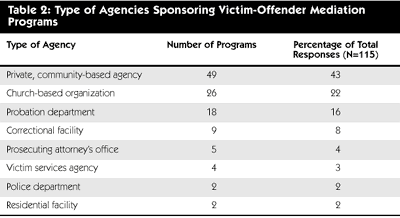
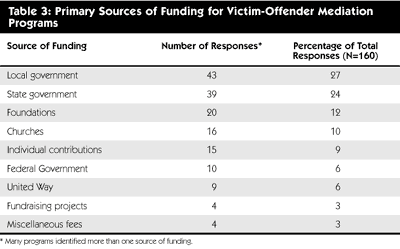
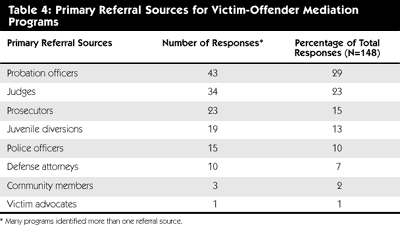
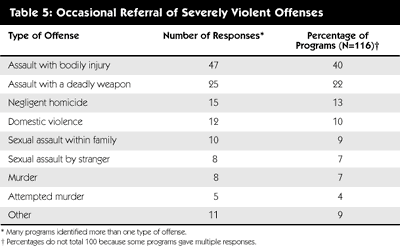
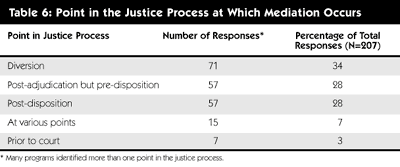
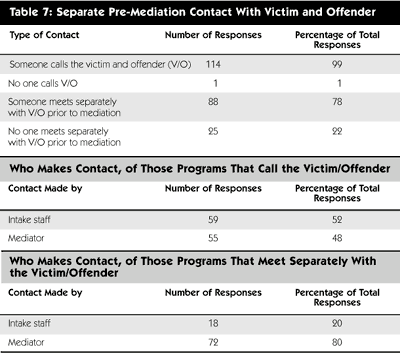
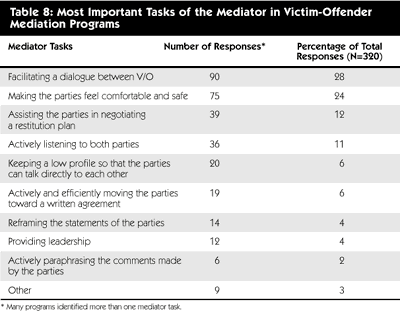
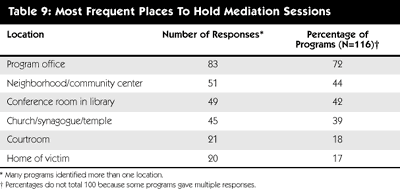


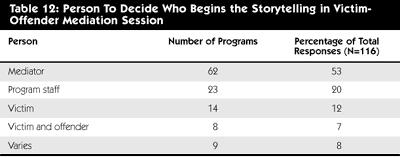

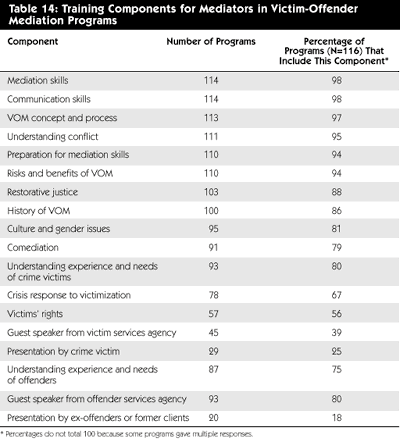
Previous
Contents
Next
National Survey of Victim-Offender
Mediation Programs in the United StatesApril 2000
